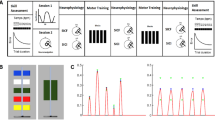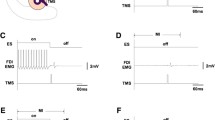Abstract.
Transcranial magnetic stimulation (TMS) was used to assess the relative contribution of the corticospinal (CS) pathway in activating the first dorsal interosseous (FDI) muscle in each hand of 16 right- (RH) and 16 left-handed (LH) subjects with varied degrees of hand preference. It was hypothesised that asymmetry in corticospinal activation of the two hands may be related to hand preference and interlimb differences in manual performance. Subjects performed isometric index finger abduction at force levels of 0.5 N, 1 N and 2 N while TMS was applied at resting threshold intensity (T), 0.9T, or 0.8T. The amount of contraction-induced facilitation of the muscle evoked potential (MEP) was used as an estimate of corticospinal involvement in the task. Patterns of MEP facilitation in each hand were compared with measures of manual performance (finger tapping speed, Purdue pegboard, maximal FDI strength). Threshold TMS intensities for an MEP in FDI at rest were similar in LH and RH subjects, and did not vary between hands. Facilitation of the MEP with voluntary activation was larger overall on the left side (P<0.05), but the asymmetry was dependent on the degree of lateralisation of hand preference. For subjects with consistent hand preference (either LH or RH), MEP facilitation in active FDI was larger for the left hand. For non-consistent RH subjects, contraction-induced MEP facilitation was larger in the right FDI muscle than the left. Asymmetry of MEP facilitation was not correlated with differences between hands in finger tapping speed or performance in the pegboard task, but was associated with relative differences in FDI strength. MEP facilitation tended to be larger in the stronger FDI muscle of the pair. We conclude that corticospinal involvement in the command for index finger abduction is generally greater when the left hand is used, although in RH subjects the asymmetry is influenced by the degree of lateralisation of hand preference. The corticospinal asymmetry is not related to speed or dexterity of finger movements, but the association with muscle strength suggests that it may be influenced in part by preferential use of one hand for tasks which strengthen the FDI muscle.
Similar content being viewed by others
Author information
Authors and Affiliations
Additional information
Electronic Publication
Rights and permissions
About this article
Cite this article
Brouwer, B., Sale, M.V. & Nordstrom, M.A. Asymmetry of motor cortex excitability during a simple motor task: relationships with handedness and manual performance. Exp Brain Res 138, 467–476 (2001). https://doi.org/10.1007/s002210100730
Received:
Accepted:
Issue Date:
DOI: https://doi.org/10.1007/s002210100730




